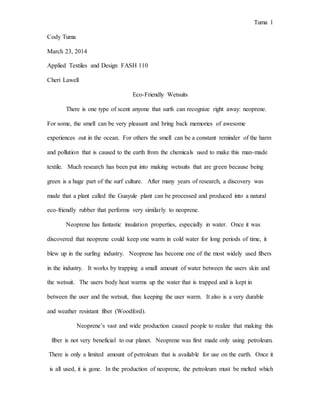
Textiles research paper
- 1. Tuma 1 Cody Tuma March 23, 2014 Applied Textiles and Design FASH 110 Cheri Lawell Eco-Friendly Wetsuits There is one type of scent anyone that surfs can recognize right away: neoprene. For some, the smell can be very pleasant and bring back memories of awesome experiences out in the ocean. For others the smell can be a constant reminder of the harm and pollution that is caused to the earth from the chemicals used to make this man-made textile. Much research has been put into making wetsuits that are green because being green is a huge part of the surf culture. After many years of research, a discovery was made that a plant called the Guayule plant can be processed and produced into a natural eco-friendly rubber that performs very similarly to neoprene. Neoprene has fantastic insulation properties, especially in water. Once it was discovered that neoprene could keep one warm in cold water for long periods of time, it blew up in the surfing industry. Neoprene has become one of the most widely used fibers in the industry. It works by trapping a small amount of water between the users skin and the wetsuit. The users body heat warms up the water that is trapped and is kept in between the user and the wetsuit, thus keeping the user warm. It also is a very durable and weather resistant fiber (Woodford). Neoprene’s vast and wide production caused people to realize that making this fiber is not very beneficial to our planet. Neoprene was first made only using petroleum. There is only a limited amount of petroleum that is available for use on the earth. Once it is all used, it is gone. In the production of neoprene, the petroleum must be melted which
- 2. Tuma 2 contributes to pollution on the earth. The chemicals that are also used in production contribute to the pollution (“Green Neoprene?”). The first advancement in making neoprene a greener fiber was to use limestone instead of petroleum. Limestone is a limited resource as well, but it is more readily available than petroleum. It is also much easier to clean up a limestone spill compared to cleaning up an oil spill. The only drawback in using limestone is that it produces the same amount of pollutants that are produced when petroleum is used as the main ingredient (“Green Neoprene?”) Since the advancement of using limestone to make neoprene, companies have been on the search for a more eco-friendly fiber that performs the same as neoprene. The companies, Patagonia and Yulex, got together and spent four years researching this. Last year they produced the first biodegradable and plant based wetsuit. The new fiber is called Yulex. It is made from the Guayule plant, which is native to Mexico and the southwest of the United States. This new discovery will forever change the surf industry (Cote). The Guayule plant needs very little water and does not do any damage to its surroundings. The plants resin is extracted from the stems and leaves of the plant. The resin is the main ingredient of the Yulex fiber. Once the resin is transformed into rubber, the rubber is processed into sheets the same way that neoprene is. They are then able to take those sheets and make it into a wetsuit. They are currently making the wetsuits out of 60% Yulex and 40% traditional neoprene. They are hoping to have 100% neoprene suits by next year (Shadley)!
- 3. Tuma 3 Patagonia has opened up this discovery to other companies that specialize in making wetsuits. They are hoping to make this a worldwide change and eliminate the use of neoprene. There is no difference in appearance or feel when Yulex is compared to traditional neoprene. The only major difference is that Yulex does not have the classic, well known neoprene scent. Team tests have proven that Yulex has more stretch and keeps the surfer warmer when it is compared to a classic neoprene suit (Shadley). After researching about this topic, it is very apparent that there is much positivity and excitement in the discovery of this new eco-friendly substitute for neoprene. This discovery can eliminate the waste and pollution that is produced when traditional petroleum and limestone neoprene is made. Neoprene is also coming back in style and is being used to make apparel in major high-end fashion companies. This new discovery not only can make a change to the surf industry but also to the entire textile industry.
- 4. Tuma 4 Works Cited Cote, Chris. "The World's First Earth-friendly Wetsuit." GrindTV.com. The Enthusiast Network, 8 Nov. 2013. Web. 22 Nov. 2014. The Footprint Chronicles. "Green Neoprene?" Green Neoprene? (2012): n. pag. Patagonia. Patagonia, 2012. Web. 10 Nov. 2014. Shadley, Steve. "Surfwear Company Markets Organic Wetsuits Made of Rubber from Arizona Shrub." KJZZ. KJZZ, 25 Mar. 2013. Web. 21 Nov. 2014. Woodford, Chris. "Wetsuits." How Do Wetsuits Work? Explain That Stuff, 8 July 2014. Web. 25 Nov. 2014.